- Articles ›
- Marketing and Strategy ›
- Marketing 3.0 – Values Driven Marketing Articles
Marketing 3.0 – Values Driven Marketing
Before we proceed, let us look ahead to take a look at the past and arrive at the present. Imagine you sit with me at an air bound coffee shop at the beginning of the 22nd Century discussing about how Marketing 8.0 is on the decline and how we need to look beyond – perhaps formulate a new version and redefine Marketing – Marketing 9.0! Farcical? Blasphemous to some?

Well then join me aboard this journey as we explore the evolution of Marketing. Let us shift backwards now – the advent of the 20th Century as a certain Mr. Ford proudly remarks “Any customer can have a car painted any color that he wants so long as it is black.” Marketing 1.0 – the Product centric era. Here Marketing was evolving and confined to a very narrow definition – it was considered as mere selling, an art of persuasion. As the consumers evolved, so did the marketers. With the advent of Information Technology, Marketing couldn’t survive solely on the product and selling concept. Let’s fast forward to the present age then, consumers are much better informed and can compare value offering of similar products at their fingertips. Their needs are changing fast and today the product value is defined by the customer. This is the age of Marketing 2.0 – the customer centric era. It entails the marketers to identify unfulfilled needs and wants and convert them into profitable opportunities. We are seeing a plethora of customized products to cater to specific needs. Standardization has passed. So for every standard Ford T of the past, you get a whole gamut of offerings each catering to different segments from niche to mass. Customers even modify the products to tailor to their needs (Dell’s Mass Customization). Consumers today are spoilt for choices.
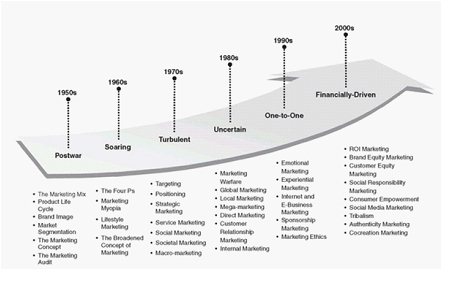
Naturally, this phase had to evolve and we are on the cusp of seeing an evolution to the next phase of Marketing – Marketing 3.0 – the human centric era , as Kotler very famously proclaimed a few years back. So what exactly is Marketing 3.0?
Before that, let us take a quick comparison between Marketing 1.0, 2.0 and now 3.0.
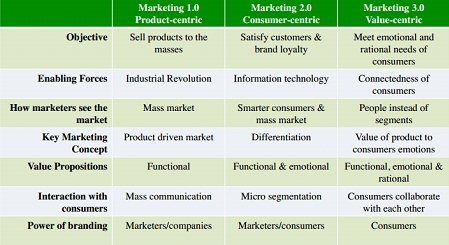
Consumers are no longer solely restricted to consumption but are getting equally involved in collaborative value creation and this age of participation essentially defines Marketing 3.0. We are witnessing a growing trend towards participative customers. Companies now collaborate with customers as marketing managers try to understand their minds and capture market insights. In some cases we can actually see customers designing and making products for themselves. Take the example of Starbucks, which has Hear Music Media Bars, a service that allows customers to create their own music CDs via tablet PCs. Back home, take the example of Tanishq - the jewellery arm of the Tata Group, which recently launched a promotion drive under the name ‘My Expression’, which invites consumers in a co-creation activity. Customers were invited to submit their own design ideas for a new line of jewellery and got to collaborate with top designers at Tanishq to come up with Mia - a new jewellery line for working women.
We are witnessing the rise of the new ‘Creative Class’. According to The Economist, not only is the customer the king: he is also the market-research head, R&D chief and product-development manager.2Customers are expressing themselves in new ways and find avenues like digital media to have their independent voices heard. They are no longer affected by one way or mass communication. The traditional objective of Positioning has always been to capture the consumer’s minds as argued by Al Ries.3 However, today Emotional marketing has developed and it’s not just the customer’s mind that is targeted. Brands look at innovative ways to connect with the customers at a subconscious level. Experiential Marketing has grown. Some Marketers were able to leverage this to their advantage even before the concept really took off. Take the example of Starbucks and its projection as ‘A Third place to drink Coffee’ or Apple’s Products which have always been more than just new Tech products for their customers. In essence Kotler defines Marketing 3.0 as values driven marketing – covering the customers’ mind, heart and spirit.4
He introduced the Values Driven Matrix5 – that essentially defines Marketing 3.0 in a nutshell.
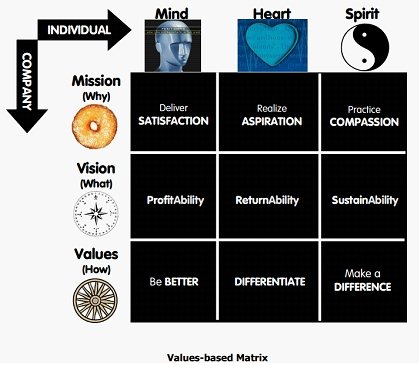
So what implications does it have for the new age Marketers prepared to embrace Marketing 3.0?
As a company tries to capture the mind,heart and the spirit of the customer, it has align its operations keeping in mind the mission, vision and the values of the company – which act as enablers. The company’s mission is represented by an inverted doughnut – as the core objective of the company remains the same while the periphery is flexible and accommodative to change. The Company’s vision is guided towards the future (as represented by the compass). Values of the company act as the guiding preamble which drives it to deliver the best offerings and thus differentiate itself from others.
Profitability and Return ability are driven by a long term plan for sustainability. Companies are being driven by not just creating economic value but also promote social progress and benefits for all. Triple Bottom Line Concept is being adopted by a number of firms bringing together – economic value, environmental health and social progress.
But what were the key drivers to this shift towards Marketing 3.0?
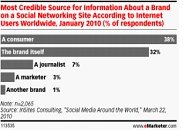
For one, the rise of technology particularly the internet and social marketing paved way for the age of participation and collaborative marketing. People trust each other more than marketers. Second, more and more collaboration tools meant more trust between customers. According to a survey by Nielson, 90% of people acted on recommendations from known people and consumer opinions posted online while traditional advertisements and text ads on mobile phones had the least credence.
The percentage of weekly social media users is at 73% of the online population. With this growing influence , customers are becoming the true marketers of a product in every sense.
Needless to say, all this requires companies to strike the right chords with the customers by connecting with them at an emotive level; collaborating with them and making them feel responsible for the product. A well-developed CSR program can go a long way in connecting with customers who are increasingly becoming cognizant of their environment and feel an urgency to do their bit. Take the example of Campbell’s Soup which recently changed the color of its packaging to Pink during the Breast Cancer Awareness Week. Not only did it serve the purpose of spreading awareness well but the benefits could also be seen in the increased demand of the product.
What approach should be followed if Marketers are to succeed at their task in Marketing 3.0?
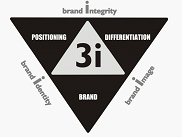
By essentially breaking up Marketing as an interplay of 3 factors – Positionig , Differentiation and Brand, Kotler designed the 3i framework6 which encompasses Brand Identity, Integrity and Image.
A Brand should be clearly positioned in the mind, heart and spirit of the custoemrs to give it a clear brand identity. Strong differnetiation is required to provide brand integrity to the positioning and in turn project a strong brand Image of the company.
With this framework and the embracing the shift towards Marketing 3.0 Marketers can make the most in this age of participation and collaborative value creation. Embrace or Perish.
This article has been authored by Utkarsh Modi from IIFT Delhi
Views expressed in the article are personal. The articles are for educational & academic purpose only, and have been uploaded by the MBA Skool Team.
If you are interested in writing articles for us, Submit Here
Share this Page on:
What is MBA Skool?About Us
MBA Skool is a Knowledge Resource for Management Students, Aspirants & Professionals.
Business Courses
Quizzes & Skills
Quizzes test your expertise in business and Skill tests evaluate your management traits
All Business Sections
Write for Us